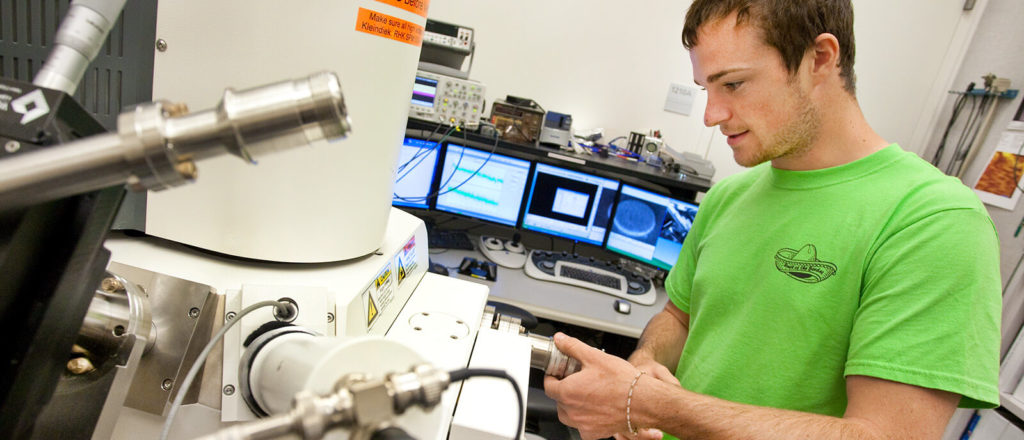
Discovering the Future, Atom by Atom
The six-story, 94,000 square-foot Molecular Foundry building at LBNL overlooks the UC Berkeley campus and, from a distance, the San Francisco Bay. Directly adjacent to the Foundry is the NCEM complex that was established in 1983 to maintain a forefront research center for electron microscopy with state-of-the-art instrumentation and expertise. Merged with the Molecular Foundry in 2014 to take advantage of growing scientific and organizational synergies, NCEM at the Foundry features 10 electron microscopes, many of which are world-leading.
Each of the six floors of the Foundry building, as well as NCEM, is managed as a technically distinct “facility” by world-class scientists equipped with state-of-the-art instrumentation, laboratories, and computational resources. Five research themes at the forefront of nanoscience integrate users, staff and techniques across all seven technical facilities, embodying the Foundry’s core capabilities and synergistic activities in synthesis, characterization, fabrication, and theory. They were developed through a comprehensive planning process undertaken in 2021, and will be regularly reviewed to evaluate their novelty, relevance, productivity, and impact. New capabilities and expertise developed in the context of internal research activities significantly augment the Foundry User Program. The themes are summarized below. To download the Molecular Foundry’s entire Strategic Plan, please use the link below.
Molecular Foundry Strategic Plan
- Architecting Information-Dense Multi-scale Materials – This theme aims to build information-dense, multi-scale materials that achieve rich functionality by controlling the energy landscape and energy flow across multiple time and length scales. Areas of focus include the development of new capabilities for understanding properties such as transport of charge, mass, and spin; dissipative response to external stimuli; and localization of sequential and parallel chemical and mechanical reactions that are made possible by multi-scale matter.
- Atomically Precise Control of Energy and Information Flow – This theme focuses on the design of function through manipulation of physical and chemical properties of nanomaterials and understanding of fundamental principles governing the emergence of function from structure. It leverages the Foundry’s expertise in precise fabrication, synthesis, and assembly, guided by the application of advanced theory, multimodal and correlated nanoscale imaging, and detailed characterization of form and function.
- Nanoscale Science Towards a Sustainable Future – Key elements of this theme are the science of electrification, biosynthesis, circularity, and separations. This theme is motivated by the role that basic science can have in addressing the constraints defined by limited resources and the negative impacts borne by an increasingly interconnected society.
- Accelerated Materials Discovery and Prediction – This theme aims to develop capabilities to accelerate materials discovery via automation and machine learning, replacing the traditional trial-and-error approach with synthesis by design and co-design of experiments and analysis. This will be accomplished through a systematic combination of high-throughput synthesis, characterization, theory, and machine learning.
- Physical and Digital Infrastructure as Drivers for Innovation – This theme focuses on the Foundry’s leadership in the implementation of strategic investments in world-class physical and digital infrastructure that enables high-impact research and is an innovation multiplier though our user program. Science at the Foundry is driven by synergistic activities in synthesis, characterization, fabrication, and theory, featuring a broad range of state-of-the-art, often one-of-a-kind instrumentation and capabilities whose impact is enhanced by combining their functionalities or defining integrated workflows.
The Molecular Foundry’s Strategic Plan is a broad scientific and organizational outline as well as a living document that will serve to guide the Molecular Foundry while enabling us to adapt to the rapidly changing research landscape. The foundation of this strategic plan is the result of a deliberative process that included many diverse perspectives. In addition to listening sessions with leaders whose expertise spans the broad field of nanoscale science, the initial draft was made available for public comment, with input solicited from the entire Foundry and scientific community in an effort to be inclusive, and to meet the needs of our users. We are also aware that the various areas, divisions, programs, and centers at Berkeley Lab all have priorities and strategic plans, and we have made an effort to position our plan within that context.his cycle of feedback remains a central part of the organization. Input from the user community is always welcome. Staff can be contacted directly here.

